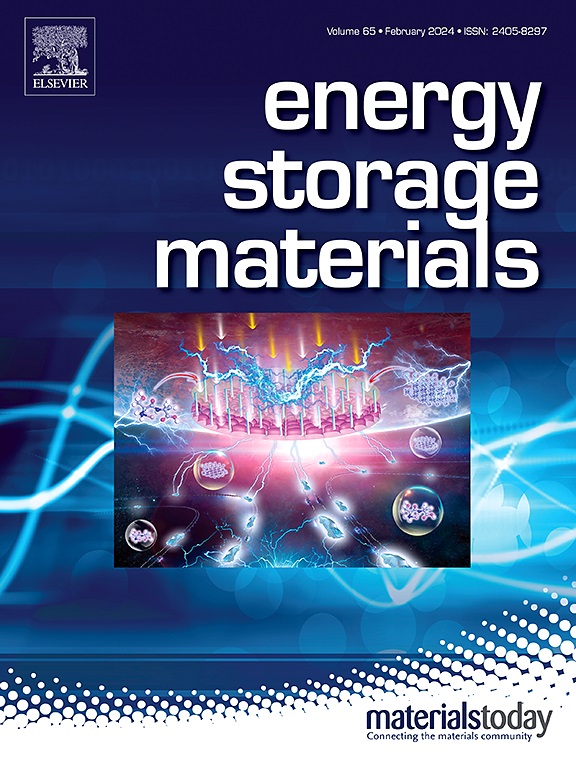用热重分析和管炉红外-质谱分析表征NMC811材料和硬币电池中的有害气体
IF 20.2
1区 材料科学
Q1 CHEMISTRY, PHYSICAL
引用次数: 0
摘要
滥用测试对于告知不同电池化学成分的风险很有用,但仅限于较大的格式。本文在较小的硬币电池水平上进行了热滥用测试,以了解排气的可燃性和毒性。氮气吹扫将产生的气体送入管式炉下游的平行傅里叶变换红外光谱仪(FTIR)和质谱仪(MS)。通过比较管式炉系统与热重分析(TGA)仪器的单组分演化气体数据,对实验系统进行了验证。验证过程中测试了多个样品,包括CaCO33、电解质、稀化NMC 811阴极和锂化石墨阳极。分离组分中HF、CO22、CO、H22、烃类等的温度分辨气体演化有助于了解排放源。还原的NMC阴极作为催化剂,在450°CC左右裂解聚丙烯分解烃为H22。在对LiPF66热分解的研究中发现,相对于在热重分析仪中分析环境敏感样品,采用硬币电池外壳作为样品夹具有一定的优势。在单组分验证后,一个充满电的NMC 811硬币电池在管式炉中失效。所测量的演化气体被发现是由单一组分试验所测量的气体组合而成的。还原阴极生成的H22比阳极生成的H22丰度更高。氟化氢排放因子和碳酸二乙酯转化排放因子有助于了解较大格式电池的气体危害。本文章由计算机程序翻译,如有差异,请以英文原文为准。


Characterizing hazardous gases from NMC811 materials and coin cells with TGA and tube-furnace FTIR-MS evolved-gas-analysis
Abuse testing is useful for informing the risks of different battery chemistries but has been limited to larger formats. This paper conducted thermal abuse tests at the smaller coin cell level to determine its relevance in specifying vent gas flammability and toxicity. A nitrogen purge carried the evolved gases into a parallel Fourier-transform infrared spectrometer (FTIR) and a mass spectrometer (MS) downstream of the tube furnace. The experimental system was validated by comparing evolved gas data for single components between the tube furnace system and a thermogravimetric analysis (TGA) instrument. Multiple samples were tested during validation, including CaCO, electrolyte, delithiated NMC 811 cathode, and lithiated graphite anode. Temperature-resolved gas evolution of HF, CO, CO, H, and hydrocarbons from isolated components helped to characterize the emission sources. A previously unreported H generation mechanism was found. It was shown that the reduced NMC cathode acts as a catalyst to crack polypropylene-decomposed hydrocarbons into H at around 450 °. It was also shown, while studying LiPF thermal decomposition, that using the tube furnace with a coin cell casing as the sample holder has some advantages for evolved-gas analysis of environmentally sensitive samples relative to testing in TGA instruments. After validation with single components, a fully charged NMC 811 coin cell was failed in the tube furnace. The measured evolved gases were found to be a combination of the species measured from the single component tests. H formation related to the reduced cathode was found to have greater abundance than H formed from the anode. Hydrogen fluoride emission factors and diethyl carbonate conversion emission factors assist in understanding the gaseous hazards for larger format cells.
求助全文
通过发布文献求助,成功后即可免费获取论文全文。
去求助
来源期刊

Energy Storage Materials
Materials Science-General Materials Science
CiteScore
33.00
自引率
5.90%
发文量
652
审稿时长
27 days
期刊介绍:
Energy Storage Materials is a global interdisciplinary journal dedicated to sharing scientific and technological advancements in materials and devices for advanced energy storage and related energy conversion, such as in metal-O2 batteries. The journal features comprehensive research articles, including full papers and short communications, as well as authoritative feature articles and reviews by leading experts in the field.
Energy Storage Materials covers a wide range of topics, including the synthesis, fabrication, structure, properties, performance, and technological applications of energy storage materials. Additionally, the journal explores strategies, policies, and developments in the field of energy storage materials and devices for sustainable energy.
Published papers are selected based on their scientific and technological significance, their ability to provide valuable new knowledge, and their relevance to the international research community.
 求助内容:
求助内容: 应助结果提醒方式:
应助结果提醒方式:


